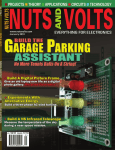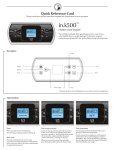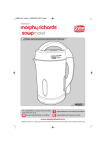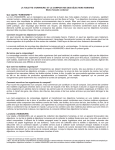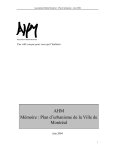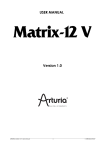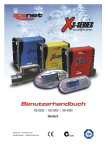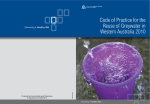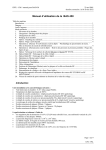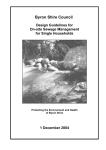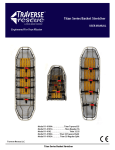Download Build Your Own Waterless Composting Toilet
Transcript
BUILD YOUR OWN WATERLESS COMPOSTING TOILET In the ONE-DAY Course you will be introduced to the design and construction of a Waterless Composting Toilet. The Course will run from 9am to 5pm and will be primarily information with handouts, supported by practical demonstration. Course Outline Overview & Historical Perspective on Managing Human Waste Taking Responsibility For your Own Waste How Successful Composting Works Safe Use of End Product Basic Design Features of Composting Toilets Local Council Approval of your Composting Toilet Determining the Size of your Composting Toilet System Design your System Sourcing the Parts for your Composting Toilet Building Your Composting Toilet Installing your Composting Toilet Managing your Composting Toilet GENERAL INTRODUCTION The Waterless Composting Toilet was probably the “original” toilet. Human excrement left lying on the ground will decompose (compost) the same as any other animal excrement. So any other form of dealing with human excrement is a refinement of the basic process. The main reason we have to deal with human waste in more sophisticated ways is due to population density. And so the level of complexity of a waste management system is generally directly related to the volume of waste needing to be treated. In a small rural dwelling on acres a fairly simple system will suffice, whereas a multi story apartment block housing up to 200 or more people requires a complex system to ensure a healthy environment. A simple system can be a “hole in the ground” or a Waterless Composting Toilet. The very basic principle of minimum impact treatment is to keep water separate from excrement. This is important, as it is the excrement that is the major source of bacteria, germs and viruses and so if water (greywater) is mixed with excrement the pollution factor is multiplied many times. The development of the flush toilet was possibly the greatest single factor in creating the massive problems currently being experienced with sewerage outfalls in our waterways. So avoiding the Flush Toilet is the best single step that can be taken to solving sewerage pollution. ORIGIN OF THE WORD “CRAP” & SHIT No, Thomas Crapper did not invent the flush toilet and thus give his name to posterity. The word crap, meaning excrement, is from the Old French, via Middle English, crappe, which stood for the grain that was trodden underfoot in a barn. The word originally derives from the Latin crappa. But there was a Thomas Crapper, and he did improve, but not invent the flush toilet. He was an Englishman, 1837-1910, who invented the ball and suction device (British Patent # 4,990) found in modern toilets that allows an efficient flush with an minimum of water and also shuts off the flow to the tank once refilled. This was a case where an appropriately named man made a contribution, not a case of an eponym. The OED2 traces its use at least to 1846, crapping ken for a water closet. Since Crapper did not invent his version of the toilet until 1882, it is obviously not the origin. Incidentally, the word craps, for the dice game, derives from the word crab and is unrelated to the term for excrement. It is a French corruption of the English term, which stood for a throw of two or three. Why the English called such a toss crabs is not known, but according to the OED2, it dates at least to 1768. The tale that it derives from the nickname of Bernard de Marigny, a New Orleans gambler (circa 1800) known as Johnny Crapaud, literally Johnny Toad, is fanciful, but not the correct etymology. Further, in the 16th and 17th centuries, everything had to be transported by ship and it was also before commercial fertilizer's invention, so large shipments of manure were common. It was shipped dry, because in dry form it weighed a lot less than when wet, but once water (at sea) hit it, it not only became heavier, but the process of fermentation began again, of which a by product is methane gas. As the stuff was stored below decks in bundles you can see what could (and did) happen. Methane began to build up below decks and the first time someone came below at night with a lantern, BOOOOM! Several ships were destroyed in this manner before it was determined just what was happening. After that, the bundles of manure were always stamped with the term "Ship High In Transit" on them which meant for the sailors to stow it high enough off the lower decks so that any water that came into the hold would not touch this volatile cargo and start the production of methane. Thus evolved the term "S.H.I.T " , (Ship High In Transport) which has come down through the centuries and is in use to this very day. TYPES OF COMPOSTING TOILETS There are TWO types of Waterless Composting Toilets and ONE Wet Composting Toilet: • Multi Chamber, Batch Cycle System. This system uses small Chambers from 60 litres to 200 litres. Once the first Chamber is full, it is removed and another Chamber is put in its place. The full Chamber is set aside to compost whilst the next Chamber starts to fill. The cycle generally takes 4 – 9 months depending on loading and climatic conditions. Schematic diagram of a Multi Chamber, Batch Cycle System • Single Chamber, Continuous Cycle System. This system uses a single large Chamber where the waste collects and is regularly removed from an access door at the base of the Chamber. Schematic diagram & illustration of a Single Chamber, Continuous Cycle System Continuous Wet Composting Cycle System: • This is a Composting toilet that uses a 3/6litre Flush toilet for those who must press the button or dislike the “long drop” experience. The Continuous Wet Composting Cycle System will process all the Greywater within the system and will compost all the kitchen waste mixed with paper & cardboard. This System can also work with a “long drop” pedestal on top of the Chamber, thus saving the water from flushing. The finished compost is removed from the bottom of the Chamber through a chute. This system does need the extra water from the Greywater to function well. SIZING OF COMPOSTING TOILETS As a general rule of thumb, use a calculation based on 0.5 litre of Chamber volume per person per day and allows a minimum of 120 days (3 months) for composting. So a family of 4 would require 240 litres of Chamber(s) in a System. A Multi Chamber Batch Cycle System would need 2 x 120 litre OR 4 x 60 litre Chambers. A Single Chamber, Continuous Cycle System would need a Chamber size of 240 litres plus. COUNCIL APPROVAL OF COMPOSTING TOILETS To design & build Waterless Composting Toilet AND obtain Council Approval you need to have a reasonable knowledge of the NSW Dept. of Health WATERLESS COMPOSTING TOILETS APPROVAL GUIDELINE, a 30-page document that details the design criteria for Waterless Composting Toilets. It does not tell you HOW to design or build them. This document can be obtained from the NSW Dept. Of Health or at the website www.health.nsw.gov.au/public-health/ehb/general/Waterlesscompostingtoiletsapprovalguideline.pdf If you are interested in taking your research further you can obtain the following: AUSTRALIAN/NEW ZEALAND STANDARD 1546.2:2001, On-site domestic wastewater treatment units, Part 2: Waterless composting toilets. A 40 page document that details the specific standards that your toilet must meet. This document can be purchased from Standards Australia for about $60; and The Australian Standard AS1547-2001, Disposal systems for effluent from domestic premises. This document can be purchased from Standards Australia for about $120. The following is a summary of the approval requirements of the NSW Dept. of Health Approval Guidelines information that is required to be submitted with an “Application to Install, Construct or Alter and Operate a System of On-site Sewage Management” under Section 68 of the Environmental Planning & Assessment Act 1979, Local Government Act 1993 (often called a Septic Application that has to be submitted for all houses not connected to mains sewage): • Design drawings for your specific application and requirements relative to the number of persons proposed to use the Waterless Composting Toilet. • Householders Reference Manual outlining installation/construction, operation & maintenance of the Waterless Composting Toilet. • Three copies of plans to scale, dimensioned and accompanied by a listing of all components and component details, including name, size, description, function, building materials and location in the Waterless Composting Toilet. All components to be shown. • Any further information required by your local Council. For support on building your loo please feel free to contact me on 6494 1051 or e-mail [email protected] KYM MOGRIDGE How a Waterless Composting Loo Works A Composting Loo works on exactly the same principle as your kitchen compost bin, only faster. The waste is collected in a small chamber directly beneath the toilet pedestal. A low powered 12 volt electric fan continually circulates air through the chamber, evaporating liquids, speeding the composting process and eliminating odours. All of the Waterlesss Composting Loo models are batch-type composting toilets that come standard with two composting chambers. Fill one, put it aside to continue composting, and put the second chamber into use. When it's time to change chambers again, the contents of the first chamber should be well and truly composted. You then remove the compost, put it on your garden or bury it, and reuse the chamber. The unique, modular Batch Cycle system means that capacity is virtually unlimited. If usage increases, you can use additional composting chambers and rotate them a little more often. How often will you need to rotate chambers? A family of four will usually fill a 200litre chamber in 6 to 9 months. A couple can expect to fill the 60litre chamber in 2 to 3 months. Why the difference? Let's take a look... So you can see, they use the same type of ventilation system, and same type of drainage to take excess liquids away from the solids. The big difference is the size. The Classic chamber is 800mm diameter and 850mm high, with a solids capacity of 150 litres. The Compact chamber is 460mm diameter and 520mm high, with a usable solids capacity of 40 litres. Did you notice the liquid drain hose in the pictures above? For more info on where the excess liquid goes once it drains through the hose, look at the picture on the next page and see how simple it is to set up an Australian Standard absorption trench: Looking after your Loo. Keeping your Loo clean and fresh is incredibly simple. Every so often, just as with a conventional flush toilet, you might need to give it a scrub with a toilet brush. When you do, use a biodegradable detergent. Better still, you could use Nature-Flush enzymes. The Composting Loo system is completely free of chemicals. Installation. Even a complete novice can install a Composting Loo in about half a day. All you need is clearance of around one metre beneath your toilet room for our larger Classic model or directly on a slab or floor for the Compact model. You can place an upstairs unit almost anywhere you want, completely independent of your downstairs unit. The TECHNICAL Stuff The way a Composting Loo works is incredibly simple. The interesting part is why it works. Moisture The moisture content of a compost pile is very important. Below 40%, organic matter will tend to dry out and not decompose rapidly. Over about 60%, not enough air can get into the pile and it can become anaerobic {no oxygen}. A moisture content of approximately 50% is ideal for composting. Nature- Loo maintains this optimum condition in 2 ways. First, the liquid waste {urine} is separated from solid waste immediately by displacing it through a perforated floor into the liquid chamber. This prevents the process from becoming anaerobic. Secondly, the semi-sealed nature of the chamber tends to keep the humidity high. That high humidity ensures that the compost pile maintains an optimum level of moisture. INFLUENCE OF TIME AND TEMPERATURE on Selected Pathogens in Night Soil and Sludge. (a) Enteric viruses (b) Shigella (c) Taenia (d) Entambeba histolytica (e) Vibrio chloreta SOURCE: Featchem and others, Sanitation and Disease. Oxygen Micro-organisms that require oxygen to survive are called aerobes. Organic materials are decomposed most rapidly by aerobes ~ much more rapidly than the anaerobes used in septic systems. Aerobes need many cubic metres of oxygen per day for rapid breakdown. A small 12 volt ventilation fan in the Composting Chamber supplies up to 420 litres of air per minute, more than enough to keep the process going at optimum levels. This has the added advantage of acting as a highly efficient extractor fan to remove rising odours from the toilet room. Temperature The heat coming from piles of organic material is generated by the feeding and multiplication of millions of micro-organisms. Technically, the stage of the temperature cycle below 40 degrees C. is termed mesophilic. Above 40 degrees C. is the thermophilic. Composting is most rapid in the thermophilic stage. As the temperature rises over 40 degrees C., mesophilic organisms die out and are replaced by an upsurge in the population of thermophilic organisms - the agents of fastest decomposition. Later, as the temperature drops, mesophilic organisms re-invade the centre of the pile from the cooler outer layer. A Waterless Composting Loo functions well in both thermophilic and mesophilic stages, but in most cases it operates in the faster, thermophilic stage. This happens for a couple of reasons ~ 1. Air is drawn into the Chamber through the toilet pedestal. As the air inside a house is usually warmer than the air outside, the chamber is also kept warmer. In colder climates, the chamber can also be insulated with a thermal insulation material. 2. The containers are black. This means they are an excellent absorber of heat, especially if located in natural sunlight. Pathogens An important function of the composting process is the destruction of pathogens. Most are killed in the thermophilic stage. Composting at temperatures above 55 degrees C. for 1 day kills almost all pathogens. As the chamber is in use for around 9 months, and is composting by itself for another 9 months, there is little chance of any pathogens surviving, even if the composting process doesn't reach the thermophilic stage. In addition, our unique use of isolated chambers ensures no recontamination from fresh waste. A typical analysis of the humus from a Compost Chamber shows no traces of Faecal Streptococci, Faecal Coliforms or Salmonella sp. Worms Worms aren't a necessity, but used in the 'out of service' chamber only, they can also play an important role in the function of a Composting Loo. By tunnelling through the compost pile, worms increase the availability of oxygen and the compost pile's ability to retain moisture. They also produce benevolent bacteria in such overwhelming numbers that disease producing bacteria find life extremely difficult. The most common 'composting' worms are the Red, Tiger, and Blue Worm. All are ferocious eaters and rapid breeders. All are commonly available from most nurseries. Worms eat up to their own body weight each day. Their by-products are called vermicast. Vermicast is an excellent fertiliser for plants - better than pure humus and it, too, is quite free of pathogens. A worm population can double in 7 - 8 weeks. This means that their processing of the contents of the chamber increases exponentially. When their food supply declines, the population diminishes, leaving a chamber full of vermicast. If there are any worms left alive, they can be transferred to the next chamber or put into the ground as a soil improver. Worms survive best in moisture and pH levels very similar to those ideal for composting. The only difference is their preferred habitat temperature of 20 - 30 degrees C. Above and below this range, the action of the worms will slow down until optimum conditions return. | Now, recall that as temperature rises over 40 degrees C., the number of thermophilic organisms increases rapidly and continue the rapid breakdown of the compost pile in the Compost Chamber. So, regardless of temperature, an ideal symbiotic relationship between macro-organisms {worms} and microorganisms ensures that the Compost Chamber works to absolute maximum efficiency. Pathogens One of the concerns many people have when using composting toilets is the presence of pathogens. Pathogens are the organisms which carry disease. Over the years, an Independent Laboratory has tested our compost at a variety of sites and have received a clean bill of health. Our most recent results are included in the following. There are four main types of pathogens: viruses, bacteria, protozoa and worms. • • • • There are more than 100 viruses that can be present in the compost pile. Among these are polioviruses and infectious hepatitus. The Salmonella species and Shigella are among the bacteria that can be found. Bacteria can lead to diarrhea, typhoid, paratyphoid, dysentry, cholera and food poisoning. Fecal Coliforms are used to indicate if there are any bacteria present. Protozoa presence can cause diarrhea, dysentery, colonic ulceration and liver abscess. Worms also cause discomfort and hookworm, roundworm and whipworm are among the commonly found worms worldwide. The roundworm, Ascaris lumbricoides is used to detect the presence of worms. Fecal Coliforms Fecal coliforms are a group of bacteria including Escherica coli (also called E. coli) and Klebsiella pneumoniae. These bacteria usually grow inside the intestinal tract of mammals and are a good indicator of fecal contamination. In a composting toilet, the fecal coliforms are usually human in origin. The presence of fecal coliforms can lead to anything from intestinal upsets to kidney damage and failure. The severity of the infection depends on the quantity of bacteria present and the constitution of the affected individual. When testing for fecal coliforms, the level of total coliforms is examined. The results are expressed as number of coliforms per 100ml of sample. The tests show all coliforms present but in a domestic situation, such as a composting toilet, the usual amount of fecal coliforms is 90% of all coliforms shown. Absence of coliforms indicates that there is no contamination. Round Worms (or Ascaris lumbricoides) Of all the worms which can infect the waste pile, A. lumbricoides is the most persistent. The eggs are a good indicator of the presence of worms in the compost pile. The eggs of the roundworm have a shell which is particularly resistant to chemicals and they can still be viable after months and in some conditions, years. However the eggs disintegrate at a temperature above 38C. The Waterlesss Composting Loo uses a thermophillic process and the pile heats to above this regularly. Pathogens are destroyed by high temperatures and by dying at the end of their natural life cycle. The Waterlesss Composting Loo system is designed to kill any pathogens that may enter the compost pile. !!Don't be too concerned!! Viruses can be transmitted only if an occupant or visitor is carrying the virus. There is a lot more chance of contamination through contact with the host than in the toilet. All of our tests have shown minimal or zero counts of E. Coli, Salmonella and Streptococci. Sewage Pollution and Water Conservation Some Facts We are gathering information regarding the damaging effects of large scale sewerage treatment plants, misuse of septic systems and water conservation problems in general. Below is a list of information we have gathered thus far. We would welcome and publish any relevant information you may have. Please include references where possible. FLUSHING A TOILET turns clean, fresh water into a pollution problem. If you have an old style, single flush toilet, up to 30% of all household water you use goes down the toilet. From there it goes into a leaking smelly septic tank or a vastly expensive and (almost without exception) inefficient sewer system. Almost all SEPTIC SYSTEMS SMELL and almost all of them leak. When they leak, they release pathogens into the water table, into rivers, lakes and dams. For many people in rural areas, that means their septic system could easily be polluting their dams and drinking water. A Waterlesss Composting Loo does not smell and does not leak. The waste remains in a completely sealed chamber until it is completely broken down. Around 40% of BRISBANE'S SEWAGE goes into the Brisbane River at Seventeen Mile Rocks. It's treated, but almost no sewage treatment plant works according to specifications. Those specifications are considered by many (most notably Greenpeace) to be thoroughly inadequate. In every State in Australia there are similar stories to be told about neglected or overloaded treatment plants, failing septic systems and large scale contamination of local groundwater and soil Australia is LOSING TOP SOIL in mammoth quantities every year. If we were able to put our properly processed sewage back into the land we could redress at least some of that damage. By pouring our sewage into the ocean, we are creating a problem from what could be a valuable resource. NORTH PINE DAM, supplying around 20% of South East Queensland's water, has been shut down at least once due to an outbreak of toxic blue-green algae. No one knows exactly why the outbreak occurred, when or where it might happen again. IN PERTH, almost a quarter of all homes are unsewered. Their leaking septic tanks are releasing all kinds of nastiness into the Swan River. As a consequence, the West Australian Government is undertaking a 10 year, $1 billion plus programme of capital works to sewer those homes. In addition to the public expenditure, compulsory connection to the sewer will cost each household between $2,000 and $14,000, plus ongoing rate costs of around $350 per year. (Source: The Australian - March '94) A Waterlesss Composting Loo style solution to this problem would involve a one off cost and (possibly) a small ongoing maintenance cost - on major wide area installations it could be logical for the local Council to run a chamber swapping system to make sure composting chambers are emptied regularly. According to the Surfrider Foundation, SEWAGE FROM SYDNEY'S new deep ocean sewage outfalls are now contaminating oysters in New Zealand. TOXIC BLUE GREEN ALGAE outbreak along the Murray/Darling river system have been attributed in large part to the sewage from towns along those rivers. These towns sill draw most of their water from the same source. Unless dramatic changes are made in the way we use that river system, further dangerous blue green algae outbreaks are a certainty. So much water is being pumped from the water table in northern Java to feed the EVER INCREASING DEMANDS OF JAKARTA that by 2025, Indonesian experts predict that the surface will begin to subside and Jakarta high rises will begin to fall down. (Source: Jakarta Post, Jan. '96) Also, much of that city's sewage goes into open drains and directly into the Java Sea untreated. The water flowing from Jakarta's canals is black in colour and stinks. If you go there, think two or three times at least before eating the fish. LOW LYING CAIRO is currently spending billions on sewage infrastructure in what remains an inadequate attempt to deal with a burgeoning population. The engineering task of digging tunnels through wet Nile sediment is consuming massive amounts of scarce resources. THE MARSHALL ISLANDS in the South West Pacific have the highest population density in the world. They, like all Pacific Island states, have a high water table and little sewage infrastructure. They are almost literally drowning in their own excrement. Almost a third of Israel's water comes from THE GOLAN HEIGHTS. What happens when and if the Golan is handed back to Syria? How solid will their peace arrangements be if they all begin to get thirsty? This situation is only getting more complex, with the announcement by Turkey of their intention to further dam the Euphrates for hydro electricity and irrigation, denying both Syria and Iraq water flow from that river. Military tensions there have been heightened as a result. (Source: The Australian, Mar '96) It has been predicted for some time that the new century will see wars over water. Given the current situation in the Middle East, it's entirely possible we'll see the first of those very early in the 21st century. AROUND 2 BILLION PEOPLE throughout the world do not have access to adequate sanitation and clean water. Given the huge costs involved, current methods are unlikely to ever meet the needs of those people. Common Questions Understandably, most people have a few questions about something as revolutionary as the Waterlesss Composting Loo. Read on for the answers. Does it smell? No. The ventilation fan works in exactly the same way as an exhaust fan in your toilet, except that air flows downward through the toilet pedestal. Odours never enter the toilet room. Also, because the breakdown process uses aerobic {with air} decomposition, the main by-products are carbon dioxide and water vapour. This contrasts dramatically with anaerobic systems {septic tanks} which produce foul smelling gases like hydrogen sulphide and methane. Is it easy to clean? Very easy. Our ceramic toilets have a larger base than the standard flush toilets, which eliminates most soiling. Also, because there is air constantly flowing down the toilet, any soiling will usually flake off and fall into the compost chamber. A damp brush with biodegradable detergent or Nature Flush enzymes should be used to clean the bowl occasionally. Does it look like a normal toilet? Yes. We designed the pedestal to look like a standard white flush toilet. Your visitors probably won't notice any difference until they lift the lid. If you'd like something a little different, you can opt for a custom coloured pedestal. Can I see the compost pile? Because the chamber and the waste chute are black, it's difficult to see waste levels in natural light. You should occasionally shine a torch down to check the level. This isn't as unpleasant as it sounds, because the contents have started breaking down from the first time you used the toilet. What else can I put down the toilet? Because it is a very efficient composting process you can put almost anything organic down the toilet and it will break down. Non-compostable materials {e.g. plastics} will stay in the chamber until you empty it. Ladies' sanitary pads and nappies or diapers will decompose very slowly and use up chamber space ~ they should be disposed of by other means. NOTE: We do not recommend placing food scraps or other household refuse in the toilet as this can attract insects and interfere with the speedy decomposition of waste. Can a Waterlesss Composting Loo be installed in a slab house? Yes. To install the Classic model, you can use one of three approaches: 1. Excavate beneath the toilet room so you have space for your composting chamber (remember to excavate out beyond the floor too, so you can drag the chamber out from under the house). You'll need 1metre of space beneath the toilet room floor. 2. Elevate your toilet room, and let the chamber sit directly on the slab. 3. Split the difference ~ excavate a bit, and elevate a bit. This approach keeps the steps up to the toilet room from being so high, and keeps the excavated area at a minimum depth. You might also consider the old cellar door arrangement outside the house, to access the chamber. If you need a toilet in a shed, weekender or workshop with a slab-floor, the Waterlesss Composting Loo Compact is ideal ~ it simply sits directly on a slab floor, requiring no through-floor fittings. Can I have an upstairs toilet? Yes. As many as you want, wherever you want them, providing the chamber can be located directly below. What if the occupancy of the house changes? No problem. Unlike the continuous systems that are on the market, the Batch Cycle Loo can grow to accommodate any size load. If your family grows, or you sell to a larger family, a Batch Cycle can easily cope with increased loads simply with the purchase of another inexpensive composting chamber. No other composting toilet currently offers this feature. I am building my house and living in a shed/caravan. Can I use Waterlesss Composting Loo now, then install it in the house when it's finished? Yes. Because of the Waterlesss Composting Loo's compact size and easy installation, you can move it wherever and whenever you want. Because it's so cheap, people often use a Waterlesss Composting Loo 'Compact' for the shed and purchase a Waterlesss Composting Loo 'Classic' for the finished home. Does it use much power? Hardly any. The exhaust fan uses less than 3 watts of electricity ~ as little as a 60 watt light bulb used for one hour per day. For people on solar or other alternate power systems, Waterlesss Composting Loo is a good option. I don't have mains power, how do I keep the fan running? If you are planning to use solar power on your property, you can use that same solar system to power your fan. If your solar system will be 24 volt, let us know and we can supply 24v fans (our standard fan is 12v). If you need to power just the fan, you can do that with either of a couple of solar panels we have available. The 5 watt panel will keep the fan running under most daylight conditions, but keep in mind that it won't keep it running at night. The 11 watt panel will keep a battery topped up so you can power your fan from the battery. It's the smallest size that will keep the fan running during 5 straight days of rain. How long do the fans last? The fans are high quality brushless ball-bearing type, designed for continuous use. On average they will last for 2-3 years. A new fan is easily installed and costs $45.00 plus postage. How many people is the Waterlesss Composting Loo designed for? The 'Classic' The standard Classic toilet, with two composting chambers, is designed to service up to 6 people on a continuous basis. Capacity can be expanded by the provision of one or more additional composting chambers. For a weekender or holiday residence, one Waterlesss Composting Loo Classic will easily handle large numbers of people with infrequent use. The 'Compact' The Compact is designed for temporary or intermittent use, although it can handle 2 people on a permanent basis. It's mainly used in weekenders, holiday huts, walking tracks, beach huts etc. I Live in a very cold climate; will the compost continue to work? The composting process will go dormant during extreme cold, but will kick in again when the temperature warms up. You may want to insulate your chamber against the cold by wrapping wall or roof insulation around it, and setting it on a sheet of styrofoam to keep it off of the cold ground. If it's really cold, you could use our wrap-around heater tape. It plugs into 240 volt power and will keep the chamber quite warm. It's a good idea to wrap insulation around the heater tape, so the surrounding cold isn't still trying to work against the heater. How long does it take to compost? The Classic chamber needs a minimum of 4 months once you've changed chambers; the compact chamber needs a minimum of 2 months. There's no need to empty it until it's time to change chambers again. Just let it continue composting until you need to rotate chambers. If the number of people using the toilet means that there would not be sufficient time for a full chamber to compost before needing to change chambers again, they can add another chamber into the rotation to give each one enough time. Can you put a Compact in a boat/motorhome/plane We have had quite a few customers who have installed compacts in trailers and buses. They tend to run the liquid drain hose to a holding tank, and empty it at appropriate places. We've also had people talk about putting them in boats and planes, but we think there are complications with each (eg. heeling) that would need consideration. We're planning to use the cabin only occasionally; do I have to do anything to the toilet if the use is to be infrequent? No. You have enough micro-organisms in your gut as part of your natural flora to start the composting process off again, even if it's been a long time since you last used the toilet. BUILDING YOUR OWN WATERLESS COMPOSTING TOILET COUNCIL APPROVAL In NSW, Local Government regulations allow you to design & build your own Waterless Composting Toilet. Or, if you don't have the time or knowledge you can have another person design & build a Waterless Composting Toilet for you. Clause 43(2) Local Government (Approvals) Regulation, 1999 enables owner/occupiers (Section b) or, a person other than the owner/occupier (Section c), to specifically design a Waterless Composting Toilet for individual premises. The Dept. of Health Advisory Note 1 provides detail of this Clause and is attached to this information and is available on the website at www.health.nsw.gov.au/publichealth/ehb/general/AdNote1.pdf To design & build Waterless Composting Toilet yourself you need to have a reasonable knowledge of: 1. WATERLESS COMPOSTING TOILETS APPROVAL GUIDELINE. A 30 page document that details the design criteria for Waterless Composting Toilets. It does not tell you HOW to design or build them. It simply tells you the criteria that your design must comply with. This document can be obtained from the NSW Dept. Of Health website at www.health.nsw.gov.au/publichealth/ehb/general/Waterlesscompostingtoiletsapprovalguideline.pdf 2. AUSTRALIAN/NEW ZEALAND STANDARD 1546.2:2001, On-site domestic wastewater treatment units, Part 2: Waterless composting toilets. A 40 page document that details the specific standards that your toilet must meet. Again, it does not tell you HOW to design or build them, just the criteria that your design must comply with. This document can be purchased from Standards Australia for about $60. You also need to be aware of Australian Standard AS1547-2001, Disposal systems for effluent from domestic premises. This document can be purchased from Standards Australia for about $120. The documentation and construction requirements are itemised below for the Local Council Approval as detailed in Clause 19.2 of the WATERLESS COMPOSTING TOILETS APPROVAL GUIDELINE, PART 3, LOCAL GOVERNMENT (APPROVALS) REGULATION 1993. Council can also require Testing of the End Product detailed in Clause 23.2, the cost of sample collecting and testing will generally be at the cost of the owner/occupier. This will be detailed in the Approval Requirements from Council and so Council does not need to be asked if they require testing. The documentation and construction requirements includes the following: 1. Design drawings & Specification for your specific application and requirements relative to the number of persons proposed to use the Waterless Composting Toilet. 2. Householders Reference Manual outlining installation/construction, operation & maintenance of the Waterless Composting Toilet. This Manual should also include a section on Trouble Shooting. 3. Three copies of plans to scale, dimensioned and accompanied by a listing of all components and component details, including name, size, description, function, building materials and location in the Waterless Composting Toilet. All components will be shown. 4. A placard that is displayed near the toilet that explains to users how to use the toilet. 5. A Record Log of the emptying dates of the Chamber/s. 6. Any further information required by your local Council. You need to see your local Council and ask them about their particular requirements for an “Application to Install, Construct or Alter and Operate a System of On-site Sewage Management” under Section 68 of the Environmental Planning & Assessment Act 1979, Local Government Act 1993 (often called a Septic Application that has to be submitted for all houses not connected to mains sewage). The object of needing to research all this information is that in the process of the research you will become very familiar with the working and maintenance of a Composting Toilet and so the system will be less likely to fail. Please contact me if you have any further questions at [email protected] phone 02 6494 1051, mobile 0427 277 249. or COMPOSTING LOO CHAMBER FILL & EMPTY RECORD Chamber 1 Date of last deposit prior to changing Date of emptying compost from chamber Chamber 2 Date of Date of last emptying deposit compost prior to from changing chamber Chamber 3 Date of Date of last emptying deposit compost prior to from changing chamber Chamber 4 Date of Date of last emptying deposit compost prior to from changing chamber ATTACH THIS LOG SHEET UNDER THE “HOW TO USE” PLACARD SUPPLIED WITH YOUR WATERLESS COMPOSTING LOO USE PLACARD TEMPLATE You are using a WATERLESS COMPOSTING TOILET To assist with the maintenance of the System could you please: 1. CLOSE the toilet seat after use. 2. DO NOT put plastics, bottles, cans or other materials that do not decompose easily, into the toilet. Toilet Paper, Tissues and plastic FREE Pads & Tampons, are acceptable. To clean use LIQUID ENZYMES or other biodegradable cleaners with a little water to rinse. For supplies of LIQUID ENZYMES contact Kym Mogridge 02 6494 1051. Composting Toilets use a variety of organisms to decompose toilet waste to produce a rich compost which can be used as a garden fertiliser. See Maintenance Manual for further details. DEPARTMENT Advisory Note 1 – October 2000 Exemption of Sewage Management Facilities to be Accredited, Application of Clause 43(2) Local Government (Approvals) Regulation, 1999. Clause 43 (1) states that council must not approve of the installation or construction of a Sewage Management Facility (SMF) unless the SMF has a current certificate of accreditation issued by the NSW Health Department. Clause 43 (2) allows exemptions for circumstances where a council may grant an approval to install or construct a SMF without a NSW Health certificate of accreditation. These circumstances are: (a) where a SMF is being installed for testing. It is not intended that a manufacturer of a SMF would be permitted to install multiple SMFs to facilitate testing. Approvals should be limited to one test installation for each manufacturer for each local government area. (b) where a SMF has been designed and is to be built by the owner or occupier of the premises on which it is to be installed. It is intended that the SMF be designed exclusively, built exclusively and used exclusively by the owner / occupier of the premises. It has recently been drawn to the attention of NSW Health that photocopied plans of home built waterless composing toilets are being freely distributed within communities. Individuals then submit these photocopied plans to council for approval under this exemption of accreditation and such actions do not comply with the exemption. This defeats the purpose that mass produced or standard design SMFs should be accredited to ensure that they protect public health and the environment. Further, the applicant has not researched the design, construction and use of the SMF and is therefore not considered to be committed to the safe operation of the SMF. Manufacturers of accredited SMFs are required to produce a quality assured product, installation and operation manuals, warranty, and other features designed specifically to teach and assist the owner / occupier in the use of the SMF. (c) where the SMF is specifically designed, by a person other than the owner / occupier for specific premises. Again it is intended that the SMF be designed exclusively for, built exclusively for, and used exclusively by the owner /occupier of the premises. Typical examples include vessels such as castinsitu septic tanks, collection wells, greywater tanks and waterless composting closets. This clause is not meant to apply to more complex systems such as aerated wastewater treatment systems, greywater treatment systems and recirculating sand systems where component parts are installed. Submission of photocopied plans to council for approval under this exemption of accreditation also does not comply with the exemption. Similarly, this defeats the purpose that mass produced or standard design SMFs should be accredited to ensure that they protect public health and the environment. The applicant is not considered to be committed to the safe operation of the SMF. Set-up of Batch Loo System Chamber heights: Polymeric Pedestal (recommended) – Blue or White Ceramic Pedestal – White (more fragile) SPECIFICATION FOR CUSTOM BUILT WATERLESS COMPOSTING TOILET This Waterless Composting Toilet has been designed in accordance with the NSW Health Department, Waterless Composting Toilets Approval Guideline, Part 3, Local Government (Approvals) Regulation 1993, and dated August 1997. Available from: www.health.nsw.gov.au/publichealth/ehb/general/Waterlesscompostingtoiletsapprovalguideline.pdf Exemption from accreditation by the NSW Department of Health is claimed under application of Clause 43(2), Part (c) of the Local Government (Approvals) Regulation, 1999. Advisory Note available from: www.health.nsw.gov.au/public-health/ehb/general/AdNote1.pdf Toilet type: Multi chamber, batch cycle, waterless composting toilet Custom built for: Bruce Foot Installation Site Address: PO Box 214, BEROWRA NSW 2081 Number of persons: 4 Number of chambers: 2 Loading: Starter base material (m3 ) / % system capacity 0.0200 m3 / 13% Human Waste (m3 ) / % system capacity 0.0946m3 / 59% Bulking materials (m3 ) / % system capacity 0.0m3 / 0% N/A Toilet paper (m3 ) / % system capacity 0.0454m3 / 28% TOTAL LOADING 0.1600m3 / 100% System=s waste volume capacity (m3 ) 0.200 m3 Loading as a percentage of system capacity 80% Carbon/nitrogen ratio: (Design assumptions - Faeces – 6% N ; Urine – 16% N ) Bulking material required to achieve C/N = 14:1 – Nil bulking required with use of toilet paper. Ventilation: 12volt. 2.8watt DC fan powered by 240/12 volt transformer, continuous running Reference Manual: A User Manual is supplied detailing: ¾ Design & Installation ¾ User Instructions for Operation & Maintenance ¾ Trouble Shooting and Signs of Failure ¾ Disposal of End Product DESIGN NOTES: Read these Design Notes and the Installation & Maintenance Manual completely prior to commencing the installation. Scale dimensions are approximate. Composting Chamber size may vary due to the use of recycled products. Where a suspended Concrete floor is used the Waste Chute will need to be in place prior to the pouring of the concrete slab. This is easier than attempting to fit the Waste Chute after the slab is in place. Ensure the flange on one end of the Waste Chute remains above the level of the finished concrete. Dimension from the ground level, where the Composting Chamber is located, to the bottom of floor bearers (timber floor) or slab (concrete floor) can be calculated by measuring the actual height of the Composting Chamber and adding a minimum of 260mm to this height. This dimension can be greater than this calculation, but NOT less. If a clearance of greater than 260mm between the top of the Composting Chamber and the bottom of floor bearers (timber floor) or slab (concrete floor) cannot be achieved then either the floor level must be raised or the ground level lowered. Often it is easier to lower the ground level by minor excavation. If excavation is carried out to lower ground level this new level must be taken into account when installing the Excess Fluid Absorption Trench. Dimensions of Excess Fluid Absorption Trench are length, 2 metres; width, 400mm; height, 400mm. Construction is 300mm depth of 20mm aggregate over 2mt length of 100mm slotted agricultural pipe, covered with Geotextile mat, and filled to original level with top soil. The final finish over the Trench need to be slightly mounded to enable runoff and reduce entry of rain. The 19mm liquid drain hose is inserted into the end of the 100mm slotted agricultural pipe prior to covering with aggregate. CARE & MAINTENANCE This information relates to a Batch Cycle Composting Toilet and needs to be adapted if applied to a Continuous Cycle Composting Toilet. Initial Maintenance Your Waterless Composting Toilet should be examined at regular intervals to ensure that the fan is working (ventilation), and the liquid discharge (moisture) connection is not blocked. If either is not working, there will usually be a tell-tale odour. To compost effectively, the pile should be kept moist (see ‘the composting process’). If it seems there is never any liquid in the liquid chamber, it may be from lack of use or high temperatures. You can overcome this by pouring extra water into the chamber each week. Fan Motor and Insect Screens You will also need to clean the insect screen at regular intervals. If the dust builds up on the screen, it will reduce the air flow, which reduces the efficiency of the Waterless Composting Toilet. Site conditions will determine the frequency of cleaning, but it is recommended to inspect it every month. If you are in a very dusty area, you may need to increase inspection rates. While you are cleaning the insect screen, you should also check that the fan is clean and rotating freely. PEDESTAL the pedestals are hand made. In order to create the unique shape required to minimise soiling, the pedestal is not as robust as mass produced toilets. The seat is solid wood and as such is heavier than the plastic seats normally supplied with standard flushing toilets. This combination means that you should never allow the seat or lid to fall freely onto the pedestal. ALWAYS REPLACE THE SEAT AND LID BY HAND. Replacement pedestals are expensive. Foreign Objects The system should not be used for the disposal of sanitary napkins or disposable diapers that contain ANY PLASTIC. REPLACEMENT OF CHAMBERS It is very important to observe safety procedures when dealing with fresh human waste. Please ensure that you wear protective clothing (gloves and old clothes). Depending on the individual, a face mask and glasses may also be necessary. The Waterless Composting Toilet chambers will need to be changed on a regular basis. If they are used consistently by the same number of people, you will soon see how often the ‘In-Use’ chamber needs to be replaced. Every few weeks you will need to shine a torch down the toilet pedestal to see if it is full. When the ‘In Use’ chamber is full, you will need to swap it with the other chamber. First, prepare the spare chamber with 15mm (1/2 inch) of bedding material and a handful of mushroom compost. Ensure these materials are insect-free or you will introduce insects into the system. Disconnect the fan assembly and liquid discharge connection at the base of the chamber. Lift the lid slightly and slide the compost chamber to one side and immediately put the spare, sealed lid on it. Before removing the full chamber, you may want to put a small bucket of mushroom compost or clean mulch, ie, sawdust, straw or grass clippings, down the chute to cover up the waste pile. This will reduce the odour, and assist the composting. The spare chamber can then be placed into position under the toilet pedestal, and the lid lowered into position. You now have an empty chamber in service and a full chamber by itself. This full chamber is best placed in a sunny position to speed up the breakdown process. For hints on effective composting techniques, see ‘The Composting Process’. Removal of Compost When the second chamber is full, the first chamber should be well and truly composted. This ‘humus’ must then be disposed of as per the local health department regulations. This normally means placing the humus in a trench 300mm deep and covering with soil. It is also recommended to wear rubber gloves and protective clothing when emptying a container. Ensure burial is not within 100m of a potable water supply. Always leave a small amount of this humus to ‘kick start’ the composting process when it goes back into service. Use it in the same way as the mushroom compost when you commissioned your Waterless Composting Toilet. Alternatively, you can add a few handfuls of compost from your active garden compost pile, or buy a bag of mushroom compost from your local nursery. Returning a Chamber to Service When the compost chamber has been emptied, you can put it back into service. Before you do this, it is a good idea to wash it with a hose to remove any solid particles. Also, ensure that all hose and vent connections are clear. Place 15 mm of bedding material on the floor and spread the humus (or mushroom compost) in the centre of the chamber. It is then ready for exchanging. If your chambers are filling up too quickly, it is very likely that your Waterless Composting Toilet is being overloaded. You will need to add another Composting Chamber and you can contact South East Worm Farms to arrange this. Cleaning the Pedestal and Seat Just like any other toilet system, you will need to clean it occasionally. To do so, use the enzyme liquid used as a compost activator, or a small amount of water with bio-degradable detergent. TROUBLE SHOOTING This information relates to a Batch Cycle Composting Toilet and needs to be adapted if applied to a Continuous Cycle Composting Toilet. Please read this section before using your toilet Waterless Composting Toilets have proven themselves to be one of the easiest systems to manage. However being a natural process, reliant on a number of factors beyond our control, it can occasionally need some help to maintain an appropriate balance. The following suggestions should assist you to sort out any problems which may arise. • THE IN USE CHAMBER IS FILLING TOO QUICKLY: This may be caused by a number of factors; The temperature is too low for effective composting. You can improve this problem by wrapping the chamber in insulating material (including the base). Insufficient air flow. This can be caused by a broken fan or the chamber being too full. Check the fan is operating and that the level of the pile is not too high. This problem could also be caused by a blocked insect screen. The positioning of the main screen in the body of the fan housing makes it a simple matter to clean. The pile being too wet. This could be the result of the outlet of the liquid chamber being blocked and causing the upper chamber to flood. (This would also cause the fan to malfunction). Check the drain hose is not blocked. If this does not seem to be the cause of the problem then the exit from the liquid chamber is probably blocked. If this is the cause of the problem you will need to change chambers and thoroughly flush out the contents of the liquid chamber through the 50mm air vent hole. Antibiotics and disinfectants will slow down or stop the process. Restart the composting by reintroducing micro-organisms by covering the pile with a 25 mm layer of mushroom compost. In many of the above situations the adding of enzymes will help solve inefficient composting by breaking down the solids and thereby speeding up decomposition. A small bottle of enzyme concentrate costs $30 including postage. It can be applied using a domestic spray dispenser. (Enzymes also reduce odours emitted from the vent pipe and are recommended for cleaning toilets and as a general multipurpose cleaner). The annual cost of using enzymes is about $20. • The out of service chamber is composting too slowly: This may happen as a result of one or more of the problems described above. At this point the most effective course of action is to aerate the pile by turning it over with a pitchfork. You could also spray enzymes from a domestic spray bottle as you turn the material and add some mushroom compost. You should also consider locating the chamber where it has a greater exposure to direct sun light, even if this means disconnecting it from the vent pipe. To encourage air to flow through the system you can attach a small solar panel to an Out of Use chamber fan. You can also introduce worms to the out of use chamber which will have the added benefit of enriching the resulting humus. If there is not enough time for any of these measures to take effect prior to rotating the chambers you might consider adding an additional chamber. If none of the above suggestions is giving the desired results it is possible that the pile is too compact or the carbon/nitrogen ratio is too low. Add, on a regular basis (try twice a week) to the in-use chamber, a cupful of fibrous material with a high carbon/nitrogen ratio (grass clippings). This will redress the imbalance and improve air flow. Alternatively increase the amount of toilet paper that you use. Please note that adding these materials will increase the speed at which the chamber fills. Good examples of such materials are shredded newspaper, rice hulls, chopped straw or wood shavings (not sawdust). • Odours coming up through the Pedestal a. b. c. Check the fan is working, if not, it may need replacing. Check that the Flexible Air hose has not filled with water in a downward “U” that may have developed between the Chamber Vent Outlet and the Fan in Housing inlet. If this has happened, disconnect one end of the Flexible Air hose and empty the water and then reposition the Flexible Air hose to prevent the downward “U” occurring again. Refer to page 13 of this Manual. Check that the Liquid Discharge is not blocked or “backed up” from the Absorption Trench. If the Liquid Discharge is blocked, change Chambers, and when the “blocked” chamber is composted flush the Liquid Discharge with water from a garden hose. Refer to page 20 of this Manual. • Vinegar Flies: Sometimes vinegar flies are attracted into the chamber and can breed. Should this problem occur in your system refer to our information on ‘How to deal with vinegar flies’. It is best however to not let them in. Another potential entry point for flies is where the lid overlaps the chute. You could apply petroleum jelly (vaseline) to the joint area however the rubber sleeve should effectively block this entry point. It is possible for flies to enter the system via the pedestal opening. If flies get into your system in this way we would suggest that your toilet room is insect screened with Solar-Mesh (call 1800 700 703) as regular insect screens are not fine enough. As the pile builds up it is more difficult for air to circulate and as a result processing is slowed down. Slowly composting piles attract flies. This situation can be improved by adding fibrous carbon rich materials (for best results this should be done from the start) as described above. Changing the chambers more often, if practical, will be beneficial. The use of enzymes can also be very helpful (again for best results this should be done from the start). Please note that broken fans should be replaced immediately in order to avoid flies entering the system. It is recommended that you keep a spare fan on hand at all times. • The odour from the out of service chamber is unpleasant: If the out of service chamber is not connected to the vent pipe it may smell immediately after it has been taken out of service. Odours can be greatly reduced or eliminated by covering the top of the pile with straw or grass clippings. You may wish to do this before disconnecting the chamber. (Please make sure you use protective clothing and gloves when handling any human waste.) HOW TO DEAL WITH VINEGAR FLIES Vinegar flies are very small and can penetrate standard fly screens. They can appear during the warmer months of the year and are attracted to materials which are decomposing. To minimise the risk of them being attracted into your toilet chamber you must ensure that the seat and lid are closed at all times, except when the toilet is in use. For other useful suggestions on how to reduce the chance of vinegar flies being attracted please refer to our ‘Trouble shooting’ information. It is important to avoid flies entering the system because once they have moved in they can multiply. Once vinegar flies have entered your chamber it is difficult to remove them. No one remedy works for all installations. We can only suggest that you experiment with the following methods which have been successful in minimising the problem. In all cases it is recommended that the treatment is carried out daily for ten days to ensure that the breeding cycle is broken. PYRETHRUM SPRAY This is a natural insect repellent and can be purchased at garden and hardware stores. The yates and mitre 10 brands have been found to be most effective. It should be sprayed directly on the pile, the sides of the chamber and the lid. It can also be sprayed into the pedestal each time you use the toilet. Wood Shavings A light covering of shavings sprinkled over the pile. Wood shavings are stocked by produce stores. (They are used on horse stable floors) COMFREY LEAVES Drop a handful of comfrey leaves into the chute, ensuring that they get into the chamber. Comfrey leaves grow wild or can be cultivated. GARDEN LIME A light covering of lime sprinkled over the pile. Lime can be purchased from most hardware stores. MULCH A thin layer of mulch as per the bedding material supplied with the Waterless Composting Toilet. Other Questions If you have any questions about the operation of your Waterless Composting Toilet please call Kym Mogridge at Adobe Loos & Worms for advise. Contact numbers are: 02 6494 1051 or 0427 277 249 THE SAWDUST TOILET This toilet is one of the most basic composting toilets to build. It can be made from various off-cuts or new materials. It is not suitable for Council Approval. The System will manage ALL the organic waste created in your home. If you are fascinated by this subject then the purchase of the Humanure Handbook, Joseph Jenkins, Jenkins Publishing 1999, ISBN 0-9644258-9-0 is highly recommended. THE COMPOST BINS A sawdust toilet requires tree components: 1) the toilet receptacle; 2) cover materials; and 3) a compost bin system. The system will NOT work without all three of these components. The toilet is only the collection stage of the process. The cornposting takes place away from the toilet, and the compost bin system is important. 1) Use at least a double-chambered, above-ground compost bin. A three-chambered bin is recommended. Deposit in one chamber for a period of time (e.g., a year), then switch to another for an equal period of time. 2) Deposit a good mix of organic material into the compost pile, including kitchen scraps. It is a good idea to put all of your organic material into the same compost bin. Pay no attention to those people who insist that humanure compost should be segregated from other compost. They are people who do not compost humanure and don't know what they're talking about. 3) Always cover humanure deposits in the toilet with an organic cover material such as sawdust, leaf mould, peat moss, rice hulls or dry lawn clippings. Always cover fresh deposits on the compost pile with coarser cover materials such as hay, weeds, straw, or leaves. Make sure that enough cover is applied so that there is neither excess liquid build-up in the toilet nor offensive odors escaping either the toilet or the compost pile. The trick to using cover material is quite simple: if smells bad or looks bad, cover it until it does neither. 4) Keep good access to the pile in order to rake the top flat, to apply bulky cover material when needed, to allow air to access the pile, and to monitor the temperature of the pile. The advantage of aerobic composting, as is typical of an above-ground pile, over relatively anaerobic composting typical of enclosed composting toilets, is that the aerobic compost will generate higher temperatures, thereby ensuring a more rapid and complete destruction of potential human pathogens. The disadvantages of a collection system requiring the regular transporting of humanure to a compost pile are obvious. They include the inconvenience of: 1) carrying the organic refuse to the compost pile; 2) keeping a supply of organic cover material available and handy to the toilet; 3) maintaining and managing the compost pile itself. NORMAL COMPOSTING BIN SEQUENCE It's very important to understand that two factors are involved in destroying potential pathogens in humanure. Along with heat, the time factor is important. Once the organic material in a compost pile has been heated by thermophilic microorganisms, it should be left to age or "season." This part of the process allows for the final decomposition to take place, decomposition that may be dominated by fungi and macro-organisms such as earthworms. Therefore, a good compost system will utilize at least two composting bins, one to fill and leave to age, and another to fill while the first is aging. A three-binned composting system is recommended, as the third bin provides a place to store cover materials, and separates the active bins so there is no possible accidental transfer of fresh material to an aging bin. When composting humanure, fill one bin first. Start the compost pile by establishing a thick layer of coarse and absorbent organic material on the bottom of the bin. This is called a "biological sponge"; its purpose is to act as a leachate barrier. The sponge may be an 18 inch layer of hay or straw, grass clippings, leaves, and/or weeds. Place the first container of the humanure/sawdust mix from the toilet directly on the top center of the sponge. Cover immediately with more straw, hay, weeds, or leaves - the cover acts as a natural "biofilter" for odor prevention, and it causes air to become trapped in the developing compost pile, making physical turning of the pile for aeration unnecessary. Continue in this manner until the bin is full, being sure to add to this bin all of the other organic material you produce. There is no need to have any other compost piles - one is enough for everything produced by the humans in your household. If you have small animals such as chickens or rabbits, their manure can go into the same compost pile. Pet manures can also go into the same compost pile as well, although pet manures, like human manures, can contain pathogens, so thermophilic composting and/or adequate aging of the compost are essential. Small dead animals can also be added to the compost pile. You need to do nothing special to prepare material for adding to the compost pile. You do not need to chop up vegetables, for example. Just chuck it all in there. Most of the things compost educators tell you cannot be composted can, in fact be composted in your humanure compost pile (such as meat, fats, oils, etc.). Add it all to the same compost pile. Anything smelly that may attract flies should be dug into the top center of the pile. Keep a shovel or pitchfork handy for this purpose and use the tool only for the compost. Keep a clean cover material over the compost at all times and rake it flat regularly. (from the Humanure Handbook, Joseph Jenkins, Jenkins Publishing 1999, ISBN 0-9644258-9-0) (from the Humanure Handbook, Joseph Jenkins, Jenkins Publishing 1999, ISBN 0-9644258-9-0) (from the Humanure Handbook, Joseph Jenkins, Jenkins Publishing 1999, ISBN 0-9644258-9-0) (from the Humanure Handbook, Joseph Jenkins, Jenkins Publishing 1999, ISBN 0-9644258-9-0) Parts List & Prices for Home Built Composting Loos PART $ Pedestal – Poly Meric Pedestal – Ceramic Waste Chute Black Plastic 5mm Drain Floor, per sq. metre (60cm x 60cm or 2ft x 2ft =$55) Large Fan in Housing with terminal box Large Fan only Small Fan in Housing with terminal box Small Fan only Transformer (Mains power to 12 volts) Moisture Trap Vent Caps Toilet Seats “O” Ring (seal between Chute & Lid) Drain Piping, 19mm x 7mts with end connector Whirlybird Wind Ventilator (for 100mm or 150mm vent pipe) 5 watt solar panel (for direct sunlight powering of fan) Liquid Enzymes, 1 lt. – Compost Accelerator & pedestal cleaner, makes 20 litres 395 450 45 150 140 70 70 45 45 20 18 45 15 15 160 190 30 Compact/Weekender Chamber Ensuite Chamber Classic Chamber 195 465 595































